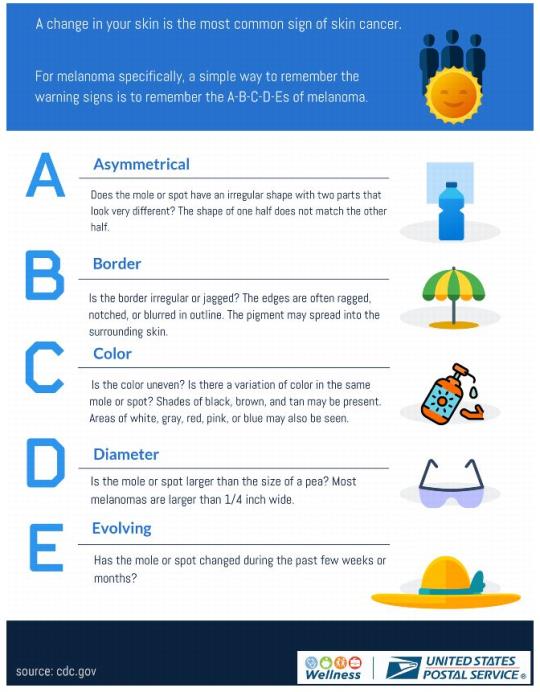Did you know that the body’s largest organ is the skin? The skin is made up of three types of cells (basal cells, squamous cells, and melanocytes) and has several layers. The two main layers of the skin are the epidermis (top layer) and the dermis (lower layer). Skin cancer begins in the epidermis.
The type of skin cancer depends on the skin cells affected by cancer. Basal cell and squamous cell cancers are the most common types of skin cancer. Melanoma is also a common type of skin cancer, and it is the deadliest because it can spread to other organs in the body.
Most cases of skin cancer are caused by overexposure to ultraviolet (UV) rays from the sun, tanning beds, or sunlamps. UV rays can damage skin cells. Over time, UV damage adds up, leading to changes in skin texture, premature skin aging, and sometimes skin cancer. UV rays also have been linked to eye conditions, such as cataracts.
A sore that doesn’t heal, a new growth, or a change in a mole can be a sign of skin cancer. A change in your skin is the most common sign of skin cancer.
Some of the risk factors for skin cancer are:
n A lighter natural skin color.
n Freckles, skin that burns or reddens easily, or becomes painful in the sun.
n Blue or green eyes.
n Blonde or red hair.
n A large number of moles of a certain type.
n A family history of skin cancer.
n A personal history of skin cancer.
n Older age.
Sun protection is important all year round and not just during the summer months. You can be impacted by UV rays on cloudy and cool days. UV rays reflect off surfaces like water, cement, sand, and snow. In the continental United States, UV rays are strongest from 10:00 a.m. to 4:00 p.m. Daylight Savings Time (9:00 a.m. to 3:00 p.m. Standard Time).
To protect your skin from harmful UV rays, you can:
n Stay in the shade.
n Wear clothing that covers your arms and legs.
n Wear a hat with a wide brim to shade your face, head, ears, and neck.
n Wear sunglasses that wrap around and block both UVA and UVB rays.
n Use a broad-spectrum sunscreen with a sun protection factor (SPF) of 15 or higher.
n Reapply sunscreen after two hours if you are in the sun and reapply after swimming.
n Avoid indoor tanning.
Check your skin often to see if there are new spots or moles and if changes have occurred in existing spots or moles. When checking your skin — specifically for melanoma — you should use the A-B-C-D-E method (see the poster below).
n Asymmetrical: Does the mole or spot have an irregular shape with two parts that look very different?
n Border: Is the border irregular or jagged?
n Color: Is the color uneven?
n Diameter: Is the mole or spot larger than the size of a pea?
n Evolving: Has the mole or spot changed during the past few weeks or months?
You can find out more information about skin cancer on the CDC website at cdc.gov/cancer/skin/basic_info/what-is-skin-cancer.htm.
— Compensation and Benefits,
Human Resources, 8-24-23
